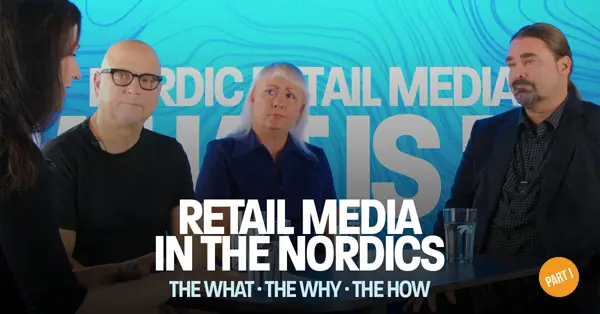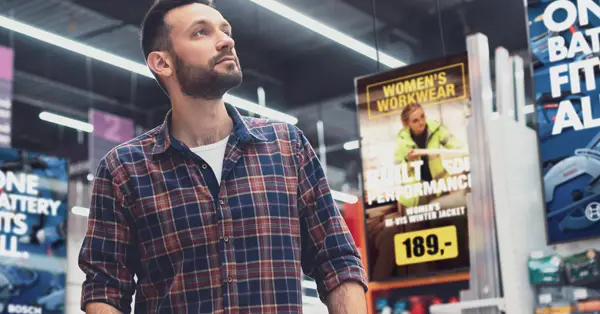Retail Media ❤️ Automation
Many of our customers and partners are familiar with the image we use to explain the various business models of in-store media.

When you look at the image more closely, you’ll notice an added layer called “Automation.”
After having had hundreds of conversations with various retailers and market players over the years, we’ve noticed that one of the biggest hurdles in launching a retail media operation is the amount of resources needed and the emergence of new tasks for organizations that have no prior experience in marketing or commercializing in-store audiences.
This is why our product development in recent years has focused on creating new automation features for our in-store retail media platform. In this article, we will present several automation development paths for in-store retail media.
Content Automation
To scale retail media in-store environments to an industrial level, the average retailer and advertisers must be able to display a vast amount of marketing material across the network. The first requirement to make this possible is, of course, the platform's architecture's ability to scale massively.

Another key development is the effort to automate the majority of content creation. This can best be understood by comparing it to the modern e-commerce to the era of retail media: ads on websites are primarily sponsored products that are automated from a database and displayed in accordance with the commercial agreement between the retailer and the brand.

Now, apply this to the in-store environment – for example, a grocery store – and the screens displaying ads. To meet the needs of the brands sold in-store and those seeking visibility, retailers must be able to offer similar automated content creation capabilities that are in use online. While custom brand videos produced by professionals will continue to be made for the largest brands, the scale required in retail media can only be achieved through content automation.
Dynamic Automated Ads

The other side of content automation is the dynamic nature of ads in grocery store environments. Ads need to be always relevant and accurate. When content automation is well implemented, ads can feature numerous dynamic elements, such as:
- Automatically retrieved product information and images from a database
- Product availability – for example, products that are out of stock in a specific store will not be shown
- Always accurate pricing, including discounts
- Prevention of displaying competing products side by side
Campaign and Targeting Automation

The core functionality of the Doohlabs platform has always been campaign and targeting automation. When we defined the requirements for the new platform with Doohlabs, we knew that traditional digital signage software was not prepared to meet the needs of the retail media revolution. We developed new features that automate campaign scheduling and distribution based on audience data. Once a campaign is booked, the material only needs to be trafficked, and the campaign is automatically displayed.
We have also further developed audience-based media sales features. Campaigns can be booked either using pre-built media products that are perfect for reaching the most popular audiences or by selecting exactly the right audience parameters with the planning tool.
Partner Automation
Retailers have numerous partners, and retail media adds a new layer to these existing partnerships.

In retail media, the largest suppliers interact so frequently with the retailer that it makes sense to offer them their own channel to manage their campaigns. On the Doohlabs platform, retail chains can open up self-service access for suppliers and, for example, media agencies, where they can book audiences and campaigns according to their agreements. Partners handle all the material traffic themselves and receive reports on the campaign's performance.
What’s Next for In-Store Retail Media?
The rise of in-store retail media as a top priority for retail chains and marketers took a while, overshadowed by the retail media revolution happening online. But now we are absolutely here – in the last 1–1.5 years, in-store retail media has been one of the hottest topics in retail media. Major research firms have also been active, and for example, Gartner has mentioned Doohlabs in two of its reports on retail development.
What happens next? The automation of everything has just begun, and it will dominate technological development for some time. Content automation has already started to merge with generative AI. It won’t be long before we see more and more automatically generated in-store ads, both in audio and video formats.
Audience-based campaigns in stores have also just taken their first steps. Retail chains with advanced loyalty programs have a uniquely deep understanding of their customer base. When these chains seriously start exploring all the possibilities to create personalized shopping experiences for consumers – and much more advanced reach for advertisers – we will see in-store experiences change significantly from how we perceive them now.
Another major development is the integration of multisensory marketing into retail media. There is already much discussion about how in-store retail media must not compromise the customer experience with excessive advertising. Adding sound, scents, lighting, and even tastings to the range of retail media tools gives marketers and store developers new ways to create excellent customer experiences. Craneworks has developed a Multi-Sensory hub to responds to this need – read more here.
---
Doohlabs is a sister company of Craneworks, developing and marketing its performance-driven in-store retail media platform internationally.







